Fishing for Crappie with a jig is one of the most common and effective ways to target these tasty fish.
However, jig fishing is not that simple on the surface. There are numerous techniques you can to improve your crappie fishing.
In this article, I’m going to cover crappie jigging basics, a few different jigging techniques, and answer the most frequently asked questions about crappie jig head size, colors and more.
This page contains affiliate links. As an Amazon Associate, I earn from qualifying purchases.
Table of Contents
How do you Crappie Fish with a Jig?
Crappie fishing with a jig can be accomplished with three main techniques: Casting and retrieving, vertical jigging, or trolling. With each technique, the goal is to present the jig as naturally as possible to trigger a bite. The weight, color, and style of the jig are important factors when crappie fishing with a jig.
What do anglers mean by ‘Crappie Jig’?
A jig is simply a hook that is weighted at the ‘head’ near where the line is tied on. Crappie jigs are small jig heads that are usually paired with some type of soft bait, such as a grub, tube, or swimbait.
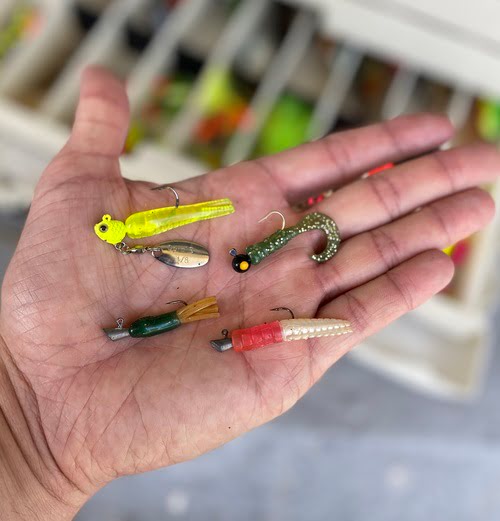
They come in a variety of shapes, sizes, and colors and there are numerous methods and techniques when fishing a crappie jig.
Cast and Retrieve Method
The casting and retrieve method is the most common way to fish a crappie jig. As the name suggests, you simply cast out the jig and retrieve it back. This method works best when trying to locate crappie, or find out how deep they are.
If you reel fast, your jig won’t go as deep and will stay closer to the surface. If you reel slow, your jig will sink and stay closer to the bottom.
Try varying your retrieve speeds to determine where fish are located. Once you get a bite, continue to cast and retrieve at the same speed and cadence.
This method works very well when crappie fishing from the bank, from a boat, or even from a dock.
For example, if you know where a brush pile is located that may be holding crappie, cast your jig out and retrieve it fast enough so it swims just above the brush pile.
Or cast it on either side of the brush pile so the jig is parallel to the brush.
Oftentimes, crappie will hit the jig as it falls, or slowly flutters down the water column near them.
You can try techniques such as stop-and reel, or bounce your rod-tip to give the jig more action. In my experience, however, less is more.
Let the jig do the work! Do not aggressively bounce or move the jig up and down. The water, wind, and movement of waves and structure will give your jig life-like movements that should trigger a bite.
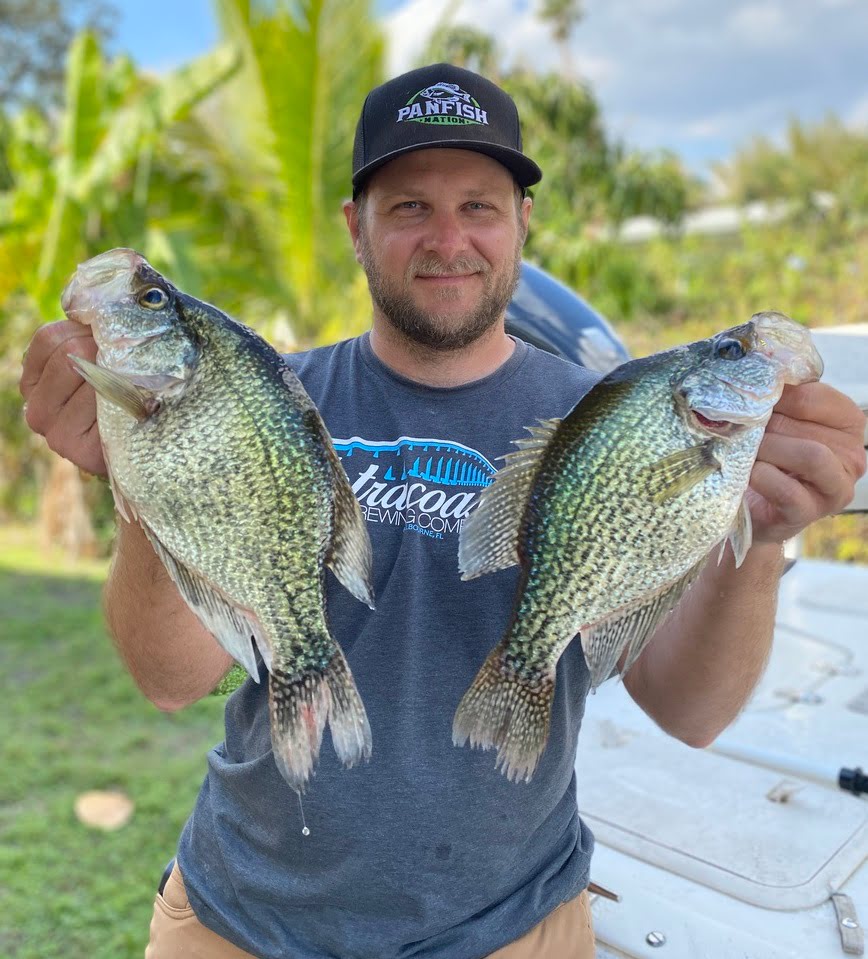
Vertical Jigging For Crappie
Vertical jigging for crappie is done when you are positioned directly over a school of crappie. This can be from a boat, a dock or when fishing from ice.
Most people use fish finders and electronics such as Livescope to scan the bottom of the lake to find deep schools of crappie during the winter or summer, then they concentrate in stable deep water areas.
Once found, anchor or position the boat and drop a jig directly down just above the school. Crappie always feed upward, above their position, so it’s important your jig is above them, not below.
With vertical jigging, you can try the yo-yo method which is to raise and lower your rod tip to give the jig a “yo-yo” effect.
This method can be effective if you are not exactly sure how deep the crappie are staging. Often times crappie will bite on the ‘fall’ of the jig as it descends back toward the bottom.
Another vertical jigging technique is just keeping it stationary at the depth the crappie are located. For example, if you think the crappie are sitting 20 feet deep, open your bail and let out ~18 feet of line.
Then close your bail and hold it in this position- do not move your rod tip or bounce it at all- I know its tempting, but dont!
Your jig will be moving under all that water, and sometimes doing too much erratic action can actually scare fish. Whenever fish are stubborn, I use a vertical stationary approach. Simply cast it out, and let the jig sit. Patience is key!
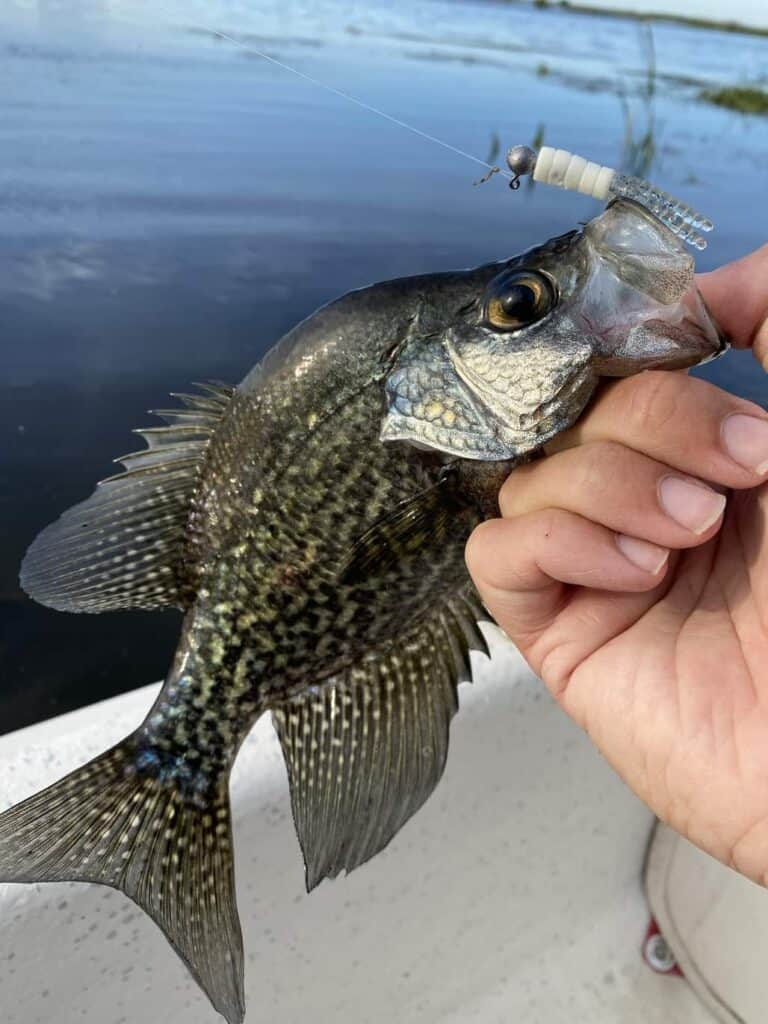
Here in Florida where I fish for crappie (we call it ‘speck fishing‘), I use vertical jigging a lot, but its actually in medium and shallow water under thick vegetation.
After cutting an opening into the matted vegetation I gently drop my jig down, and slowly jig it up and down for the crappie waiting below.
What If Crappie Wont Bite My Jig?
If you are able to locate crappie, but you cant get them to bite your vertical jig try two things:
First, downsize your jig. If you are using a 1/8 ounce jig head, downsize to a 1/16, etc. Using a smaller profile bait will help entice bites from stubborn fish.
Second, try tipping your crappie jig with minnows, spikes (maggots), or artificial crappie bites. Crappie also feed off scent, and anything that smells like a common food source can give stubborn crappie extra incentive to bite.
Trolling Jigs For Crappie
Trolling jigs is very effective when fishing for scattered crappie, or in very large bodies of water where you are covering a lot of water to find fish.
There are numerous rigs and methods for trolling jigs. You can use an elaborate spider-rig setup to troll jigs (with up to 10 rods extending out from the boat like spider legs), or simply troll with one or two rods.
When trolling for crappie the key is to select a jig head style and weight that is going to keep the lure at the correct depth, and troll at a slow speed to keep your jig in the strike zone.
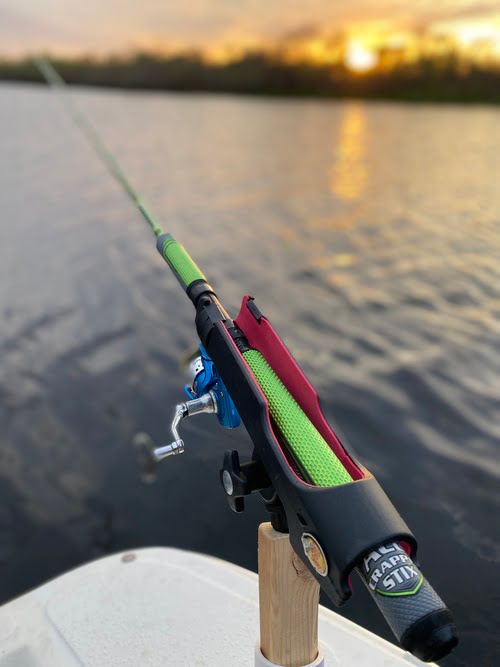
For example, let’s say you are trolling a portion of the lake that is 15 feet deep, and the crappie are sitting in 8-12 feet of water. You’ll want to choose a jig heavy enough, to sink down to 8-12 feet even while in motion.
Selecting the correct jig weight for trolling just takes a little practice and trial and error.
Trolling for Crappie is done very slowly, usually at a speed of .5-1mph. A trolling motor on the low setting works very well or using the wind to gently drift the boat.
Trolling for crappie is very effective on large reservoirs, rivers, and big lakes. Try trolling over channels, ledges, points, coves, and submerged timber. Once you get a bite, drop a marker buoy and circle back to that same area and troll through again.
After a few attempts, you can usually find a pattern of how deep the crappie are staging and where they are located.
Punching Through Vegetation With Jigs
Another method worth mentioning is something bass anglers may be familiar with, and that is punching through vegetation.
In lakes with heavy and thick cover, crappie will often congregate under these shaded mats of hyacinths, lilypads, and duckweed.
By punching a hole directly into the vegetation you can drop your jig directly down…and crappie love it!
In my home state of Florida, that is the exact method I use to catch specks during the spring spawning season. I use a small rake, punch a hole just big enough to pull out a fish, and start jigging!
I find the ideal depth is 2-5 feet deep, especially when the crappie are spawning.
What Is The Best Jig To Use For Crappie?
The best jig to use for crappie is the style, color, and weight that triggers the most bites where you are fishing. Popular choices are the Marabou style jig and the Blakemore Road Runner.
My personal favorite is a Crappie Magnet system due to its unique ‘horizontal drop’ presentation. Plus, they come in tons of different colors and their jig heads are specifically designed for thier soft bait bodies.
When starting out, experiment with different jigs. For example, try a natural color such as lead with green. If you don’t get any bites, try a bright color such as yellow with pink. Always experiment with colors and styles- that’s half the fun!
There are no shortage of Crappie jigs, baits and lures available on the market. Half the fun is experimenting and finding what works best in your area!
What Weight Jig Head Is Best For Crappie?
Crappie jig heads range in size from as small as 1/64th of an ounce all the way to 1/2 ounce. The best-sized jigs are 1/8th, 1/16th, and 1/32 of an ounce.
Chartreuse, red, and white are the most popular colors. Pair these jig heads with a live minnow or soft bait for the best chance of success.
Remember, crappie fishing is not complicated…but sometimes they are just picky and you have to keep trying different variations!
How To Rig A Jig For Crappie
Single jig rig
A single jig rig, is exactly what it sounds like. A single jig tied to the end of your line. This is most commonly used with the casting and retrieving method, or with vertical jigging or punching.
It’s important when tying on a jig you use a knot that will allow the jig to move freely in the water without restriction.
Popular knots include the Trilene knot or loop knot. Simply attach your jig directly to your fishing line; in most cases a leader is not necessary.
Double jig rig
A double crappie rig allows for two jig heads to be fished at once from the same fishing line.
This means more chances of getting bit and allows you to use two different colors, or style of jigs to see what fish are biting.
This video does a great job of how to tie a double crappie rig, using your mainline and a Palomar knot.
How Do You Catch A Crappie With A Jig And Bobber?
A jig and bobber is one of the easiest and most effective ways to catch crappie.
The bobber gives you a visual indicator of any bites taking below the surface, and keeps your jig ‘suspended‘ in the water column above structure or vegetation it may otherwise get snagged on.
This method works especially well when crappie have moved into shallow water during the spring spawning season, or if they are staging along ledges in medium depth (6-10 feet).
Simply drop your jig and slip bobber into small openings around vegetation and structure where crappie are spawning. Let the jig sit and watch your bobber carefully. Give your rod tip a small twitch every few minutes.
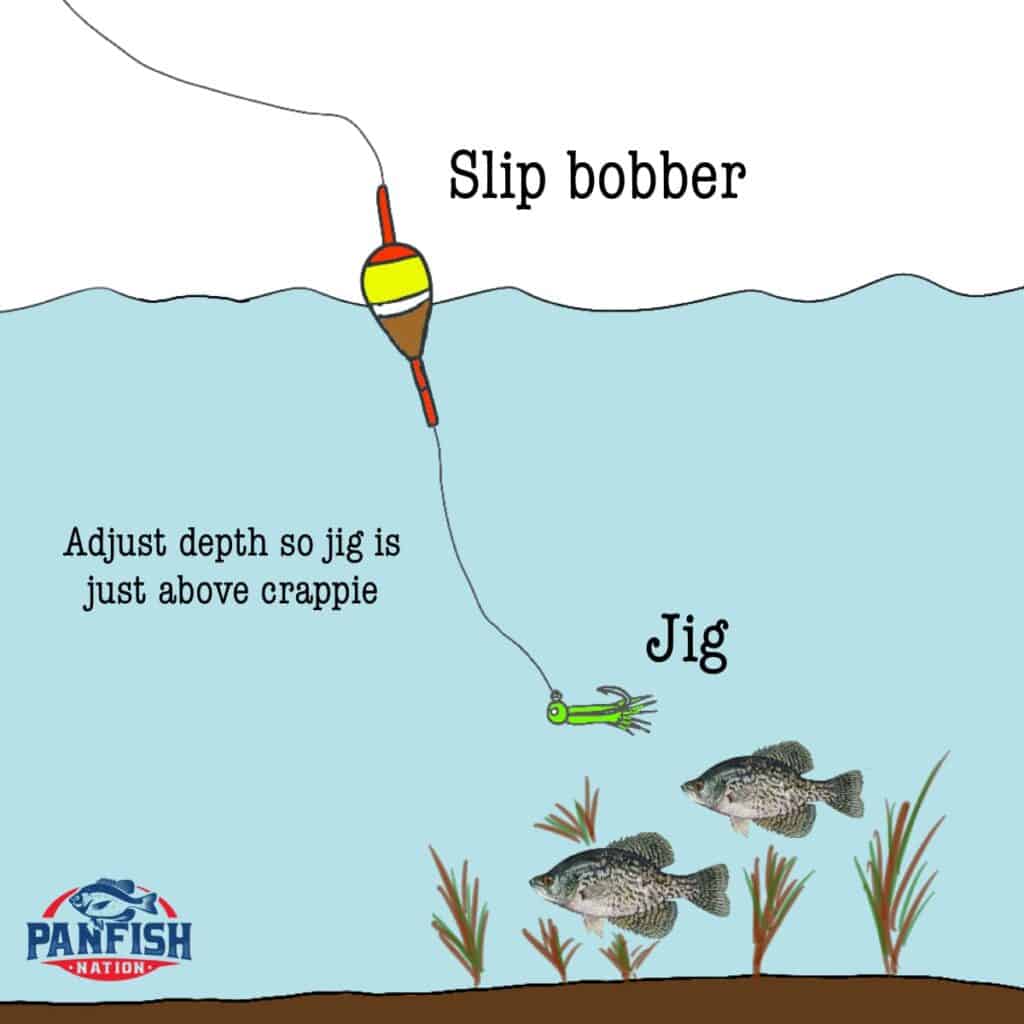
This method works great in open water or in vegetation such as lily pads. Try it on on an ultralight rig, or a cane pole such as the B&M Black Widow Crappie Pole.
How To Jig For Crappie From The Bank
To jig for crappie from the bank use the cast and retrieve method. This will allow you to reach out to deeper depths where crappie may be located, or stay in close near shoreline vegetation.
Try adding a bobber as well to assist with casting and preventing snags.
Slowly reel in your jig at a steady pace to keep it suspended through the water column.
If you are fishing in deep water, allow the jig to fall naturally before reeling but keep tension on the line so you can feel the small ‘tink‘ of a biting crappie.
Does Jig Head Color Matter For Crappie?
Jig head color does matter when fishing for Crappie. Choosing the correct color may be the difference between no bites or a cooler full of fish.
Crappie have excellent eyesight, and they are notoriously picky so the color choice can have big impacts when fishing.
Both Black and White Crappie have rods and cones in their eyes just like humans, so they are able to see light and colors underwater. They have excellent eyesight and one of the largest eye-to-body-size ratios of any freshwater fish.
This allows them to see in deep dark conditions, or in conditions of very low light and even in muddy water.
Understanding the light and color spectrum underwater will help you determine which colors to use.
As a general rule of thumb, brighter colors such as chartreuse, pink and yellow will work well in stained or dark water and natural colors like brown, clear, and green will work well in clear water.
Depending on how deep you are fishing, it’s important to also understand that certain colors lose their visibility at descending water depth.
For example, if I am vertical jigging Crappie in 40 feet of water in a deep reservoir, I’m going to avoid red or orange since they are the first colors lost in the spectrum, and instead try something like green, blue or black.
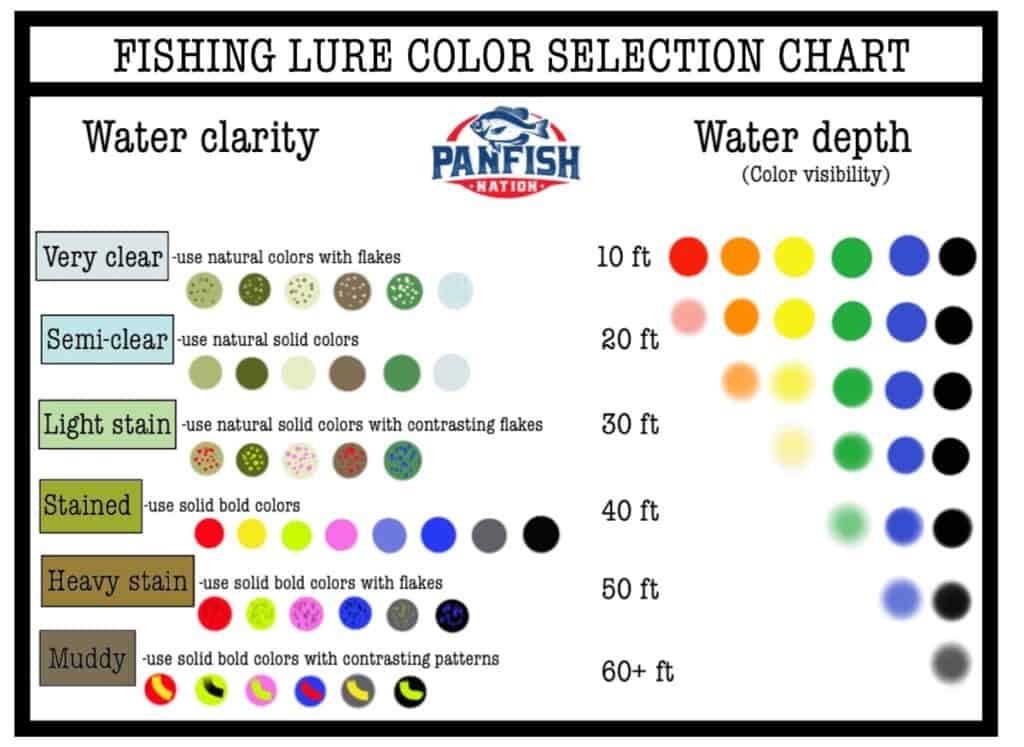
Best color crappie jig for clear water
In clear water, select a jig and soft bait combo that is a natural color. This includes colors like green, brown, silver, and translucent.
If the area you are fishing has a lot of shad and minnows, try to match your jig color to their natural color (silver/blue). If there is a lot of crawfish, try brown or red toned jigs.
Best color crappie jig for stained water
For stained water select a jig that is a bold color. Red, yellow, chartreuse, and pink are all good options.
The goal is to pick a jig color that will stand out among the stained water, without seeming unnatural. Experiment with different colors, flakes, and patterns to find what is getting the most reactions.
Best color jig for crappie at night
Crappie are very active at night, and fishing for them after the sun has gone down can be very effective.
Try choosing jigs and colors that match the water clarity. For example, if the lake is very clear, I’m going to use natural colors with light flaking.
If it’s very muddy, I’m going to use bold colors with contrasting patterns such as black/lime or red/yellow.
TIP FOR CRAPPIE FISHING AT NIGHT: Use a green underwater LED light to take your night fishing to the next level. The bright green light attracts zooplankton and baitfish. This in turn attracts Crappie and can be incredibly effective!
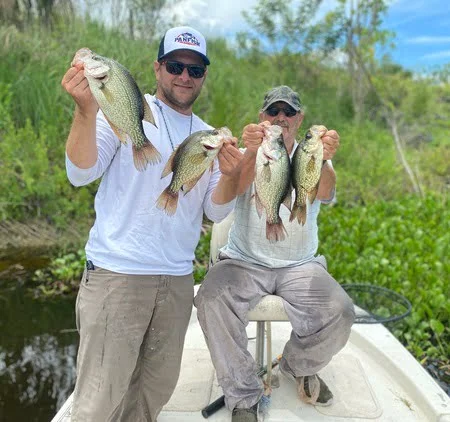
Best Fishing Line For Crappie Jigging
Crappie Fishing line comes in a variety of styles and colors and each type has its pros and cons. I personally prefer either braided line or monofilament.
Your choice may depend on the water clarity of where you are fishing and which technique you are using.
Let’s take a look at the 3 main types of Crappie fishing line:
Monofilament Line For Crappie Jigging
Monofilament line is the most affordable and best all around line to use when jigging for crappie. It works great on ultralight setups, and cane poles.
| Monofilament PROS | Monofilament CONS |
|---|---|
| Very affordable | Not as sensitive |
| Easy to cast | Absorbs UV light (weakens over time) |
| Many color options to choose from (high-vis) | Retains memory |
| Abrasion-resistant | Low density; high stretch |
Braided Line For Crappie Jigging
Braided line offers the great sensitivity and least amount of stretch, which makes it ideal for trolling and ice fishing jigs for crappie.
| Braided Line PROS | Braided Line CONS |
|---|---|
| Excellent casting ability | Not abrasion resistant |
| Very high sensitivity | No low visibility options |
| Color options available | Poor knot strength |
| Zero stretch | Easy to tangle (wind knots, etc) |
Fluorocarbon Line For Crappie Jigging
Fluorocarbon line is nearly invisible underwater, making it great for those crystal clear lakes and reservoirs. Its very sensitive which makes it great for punching crappie jigs into vegetation.
| Fluorocarbon Line PROS | Fluorocarbon Line CONS |
| High density; low stretch line | Expensive |
| Excellent sensitivity | No color options are available |
| Almost invisible underwater | Poor abrasion resistance |
| Great knot-strength | High memory |
Final Thoughts
There is a reason why there are so many different styles of jigs and techniques for crappie fishing; it’s because jig fishing for crappie is immensely popular and extremely effective.
With so many choices out there, it can be a daunting task figuring out what to use, and how to use it.
But keep it simple. Less is usually more, and with enough experimentation you’ll find the style of fishing and jig type you prefer.
Thank you very much for reading, and if you have any questions please let me know!
See Also: What is The Best Time Of Year To Catch Crappie?
If you haven’t guessed yet, I love fishing and everything about it!
To learn more about why I started Panfish Nation, visit the About page and follow along on Social Media:


Download a copy of my FREE Lure Color Selection Chart & Knot Guide!
Stay up to date with fishing reports, tackle reviews, industry news, and much more! We respect your privacy, unsubscribe at any time.
